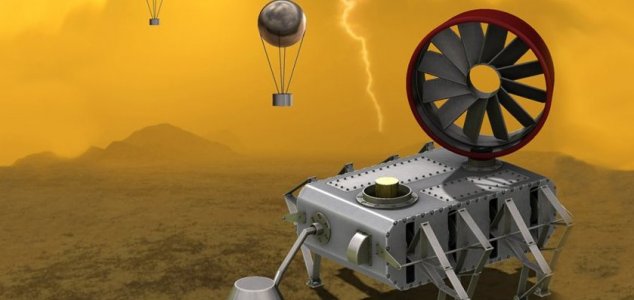Space & Astronomy
August 29, 2017 · 15 comments
15 comments

The design is certainly unique. Image Credit: ESA/J. Whatmore/NASA/JPL-Caltech
Previous efforts by Russia to land probes on its surface in the 1970s were met with only limited success due to the spacecraft typically lasting little more than an hour before failing.
The design for NASA's upcoming Automaton Rover for Extreme Environments (AREE) project therefore will need to be extremely sturdy if it is going to have a chance of surviving for very long.
To this end, scientists have decided to ditch the idea of using standard electronic components entirely in favor of an old-fashioned clockwork computer powered by the planet's strong winds.
The design they've come up with, which looks like something out of a 1950s science fiction movie, would even utilize Morse code as a means with which to communicate with the Earth.
"Venus is too inhospitable for kind of complex control systems you have on a Mars rover," said JPL mechanical engineer Jonathan Sauder.
"But with a fully mechanical rover, you might be able to survive as long as a year."
Source: Gizmodo | Comments (15)
NASA is developing a clockwork Venus probe
By T.K. RandallAugust 29, 2017 ·
 15 comments
15 comments
The design is certainly unique. Image Credit: ESA/J. Whatmore/NASA/JPL-Caltech
The atmospheric conditions on Venus are so hostile that NASA's next probe may use a mechanical computer.
With surface temperatures exceeding 860 degrees and crushing atmospheric pressures that are more than 100 times those found on the Earth, Venus is an extremely inhospitable place to go exploring.Previous efforts by Russia to land probes on its surface in the 1970s were met with only limited success due to the spacecraft typically lasting little more than an hour before failing.
The design for NASA's upcoming Automaton Rover for Extreme Environments (AREE) project therefore will need to be extremely sturdy if it is going to have a chance of surviving for very long.
The design they've come up with, which looks like something out of a 1950s science fiction movie, would even utilize Morse code as a means with which to communicate with the Earth.
"Venus is too inhospitable for kind of complex control systems you have on a Mars rover," said JPL mechanical engineer Jonathan Sauder.
"But with a fully mechanical rover, you might be able to survive as long as a year."
Source: Gizmodo | Comments (15)

The Unexplained Mysteries
Book of Weird News
AVAILABLE NOW
Take a walk on the weird side with this compilation of some of the weirdest stories ever to grace the pages of a newspaper.
Click here to learn more

Support us on Patreon
BONUS CONTENTFor less than the cost of a cup of coffee, you can gain access to a wide range of exclusive perks including our popular 'Lost Ghost Stories' series.
Click here to learn more
Israel, Palestine and the Middle-East
United States and the Americas
Philosophy and Psychology
Modern Mysteries, New Age and Prophecies
Total Posts: 7,768,269 Topics: 325,020 Members: 203,765
Not a member yet ? Click here to join - registration is free and only takes a moment!
Not a member yet ? Click here to join - registration is free and only takes a moment!

































Please Login or Register to post a comment.